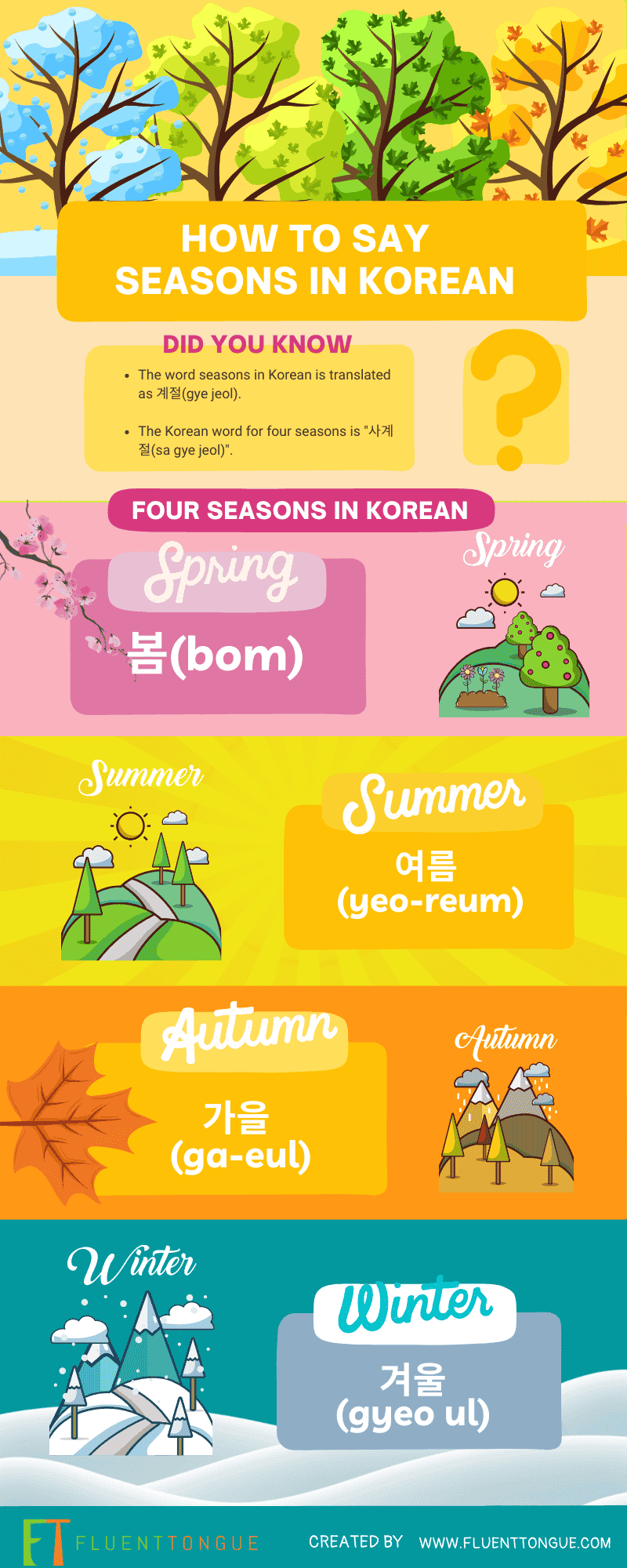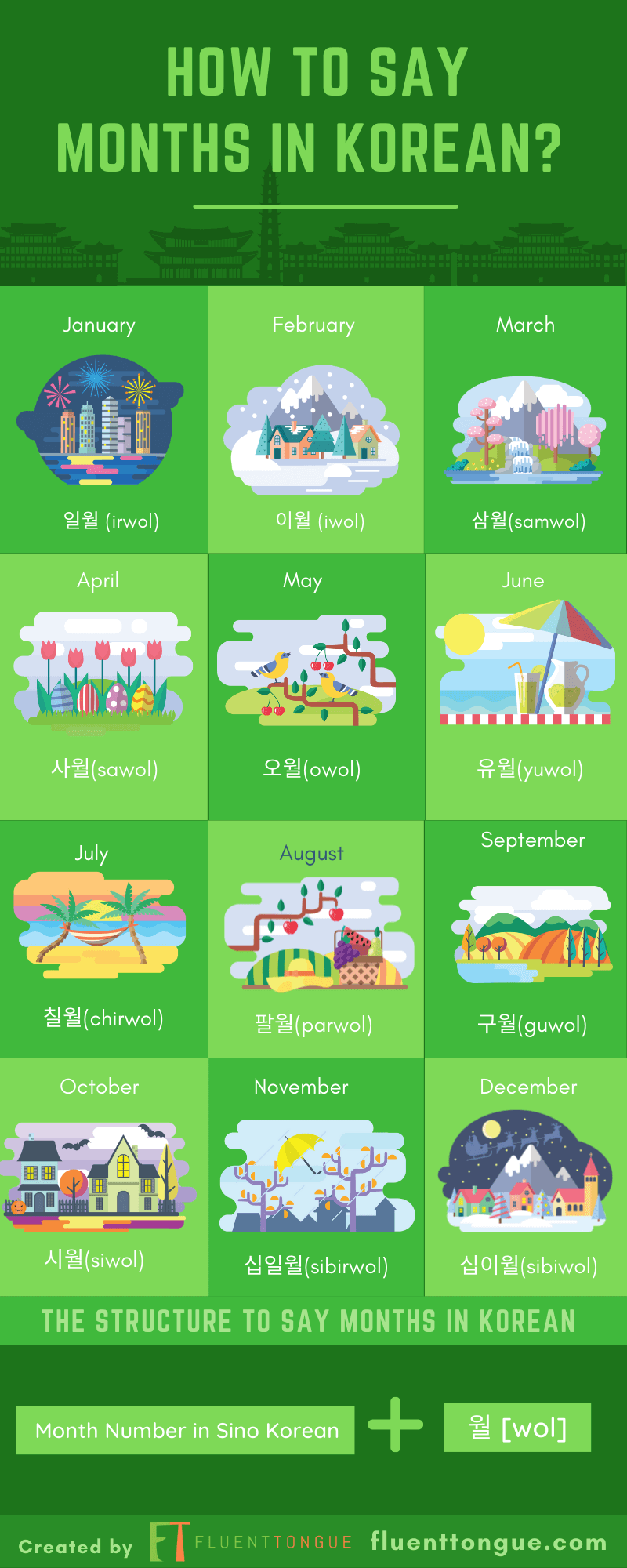Whether you’re making travel plans or chatting with Korean friends and family, how to say seasons in Korean will come in handy?
In fact, Talking about the weather & seasons is a great way to start a casual conversation.
The word seasons in Korean is translated as 계절(gye jeol). The word for four seasons is translated as “사계절(sa gye jeol)”.
Here’s how to pronounce all 4 seasons in Korean with hangul and their romanization.
- Spring (March ~ June) – 봄(bom)
- Summer (June ~ August) – 여름 (yeo-reum)
- Autumn (September ~ November) – 가을 (ga-eul)
- Winter (December ~ February) – 겨울(gyeo ul).
We‘ll show you how to talk about the seasons in Korean and common Korean seasons vocabulary for all four distinct seasons in Korea with real-life sentences
Alright world, it’s time to dig in (to the core)
Table of Contents
How to say “seasons” in Korean?|describe Four seasons in Korean.
계절(gye jeol) means seasons in Korean. The Korean word for four seasons is “사계절(sa gye jeol)”. The words for the four seasons in Korean are: Spring is “봄(bom), “여름(yeo leum) is summer, “Autumn is “가을(ga eul)”and “겨울(gyeo ul)” is called winter in Korean.
The Korean spring runs from March to May. Autumn is during the months from September to November, and winter German winters are between December to February.
Thanks to Korean, it is easy to use these words in Korean sentences with verbs and nouns directly. You can safely use it with all groups of people, and nobody will get offended.

Spring In Korean

The Korean word for spring is 봄(bom). In Korea, spring generally starts in March and ends in May with temperatures ranging from 1 to 25 °C while chilly at night.
The spring season in Korea is most well-known for cherry blossoms (벚꽃 in Korean), especially in the city of Gyeongju. You’ll also see other flowers such as azaleas, tulips, and canola flowers everywhere.
The locals head for the hills and visit many National Parks, such as Songnisan, Seoraksan, and Jirisan.
So this is one of the best times to visit Korea with your loved ones and enjoy a lot of outdoor activity, with ideal temperatures and less humidity.
Example
Do you like spring?
봄 좋아하세요?
I like spring the best.
저는 봄이 제일 좋아요.
Jeju island looks its best in the spring.
제주도는 봄에 가장 좋아 보여요.jejudoneun bome gajang joa boyoyo
Spring has finally come.
드디어 봄이 왔다.deudio bomi wattta
Summer In Korean

Summer in Korean translates to 여름(yeo leum). In Korea, Summer is from June to August. It is the hottest time of the year in South Korea. Temperatures may range between 23°C and 30°C. But due to the monsoon, it rains heavily during these months.
You’ll see the popular Haeundae Beach and the southern holiday island of Jeju is packed with people and parasols.
Example
I go to Busan every summer.
이번 여름에 호주에 갔었어.
Summer is hot, dry, and windy.
여름은 덥고 건조하고 바람이 분다.
I prefer summer to winter.
나는 겨울보다 여름이 더 좋다.
What did you do this summer?
이번 여름엔 뭘 했어요?
I’m gonna study English in the US during summer vacation.
여름방학 동안 미국에서 영어 공부할 거야.
How was your summer holiday?
이번 여름휴가는 어땠어요?”
Summer in Seoul is hot and humid.
서울의 여름은 덥고 습하다.
The movie was released this summer.
이 영화는 올 여름에 개봉되었다.
How to say Autumn in Korean?

The Korean word for autumn is. 가을 (ga-eul). Autumn in Korea falls from September to late November with maximum temperatures around 20/22 °C. In addition, it usually rains less than in spring.
This is the season when you get to see the trees turn vivid hues of red, orange, and yellow, particularly throughout the country’s National Parks such as Songnisan, Jirisan, and Seoraksan.
Locals usually visit Nami Island to get some of the most stunning autumn views of nature this time.
Autumn and spring are the best time of year to visit South Korea with your loved ones due to The mild temperatures, low rainfall, and natural beauty
Example sentences using autumn in Korean
- I love the autumn breeze.
가을의 산들바람 너무 좋아.
- It is windy in the autumn.
가을에는 바람이 많이 불어요.
- I love the night sky in autumn.
난 가을 밤하늘이 정말 좋아요.
- I collect fallen leaves every autumn.
매년 가을에 낙엽을 모은다.
- Autumn is a great season to travel.
가을은 여행하기에 제일 좋은 계절이다.
- Autumn is cool and bright and the skies are clear.
가을은 시원하고 청명하며 하늘은 맑다.
- I hate summer and winter, but I love spring and fall.
나는 여름이랑 겨울이 싫어. 하지만 봄이랑 가을은 좋아.
Winter In Korean

겨울(gyeo ul) means Winter In Korean. The season of winter is from December to February with temperatures ranging between minus six degrees and three degrees Celsius.
The long winter is freezing cold and dry. Winter is the time when you get to see pools of snow from frozen water especially in mountainous regions in Gangwon-do receives snowfall starting in early winter.
Korean people believe the first snow can be lucky for a long-lasting relationship if you can enjoy it with your loved ones. you can enjoy winter sports like skiing and snowboarding at the ski resorts in the Gyeonggi-do Province and in Gangwon-do.
Major holidays between the months of December and February are Christmas, New Year and Lunar New Year, and the months of February and early March are the time for Valentine’s Day, and graduation ceremonies.
Example
- We’ve had a lot of snow this winter.
이번 겨울에는 눈이 많이 왔습니다.
- Gukhwa-ppang is my favorite snack in winter.
국화빵은 겨울에 제가 좋아하는 간식이에요.
- I miss the winter weather in Seoul.
서울의 겨울 날씨가 그리워.
- I enjoy fishing on ice in the winter.
나는 겨울에 얼음낚시하는 것을 좋아한다.
- Warm clothes are a must in winter.
겨울철에는 따뜻한 옷이 꼭 있어야 한다.
- Do you ever go ice skating in the winter?
겨울이 되면 스케이트를 타러 가니?
- My skin gets really dry, especially during winter.
내 피부는 특히 겨울에 정말로 건조해져.
- I have no winter coat.
나는 겨울 코트가 하나도 없다
- This winter has been colder than usual.
이번 겨울은 예년보다 춥습니다.
- Winter always makes me lazy. I don’t wanna leave the house or do anything.
겨울엔 항상 게을러져. 집에서 나가기도 싫고 아무것도 하기 싫어.
How To Say Seasons In Korean Sentences?
Single words are hard to use on their own. So you might want to know how to actually use these in a sentence.
So let’s start with basic questions in Korean about seasons.
Which season do you like?
어느 계절을 좋아해요?
[eo-neu kye-jeol-eul joh-a-hae-yo?]
To answer, you can say:
I like summer.
저는 여름을 좋아해요.
jeo-neun yeo-reum-eul joh-a-hae-yo.
Here are other common questions about seasons in Korean
What is your favorite season?
어떤 계절을 가장 좋아해요?otton gyejoreul gajang joahaeyo
My favorite season is summer.
좋아하는 계절은 여름이에요.joahaneun gyejoreun yoreumieyo
What’s the weather like in Korea in the spring?
한국의 봄 날씨는 어때요? hanguge bom nalssineun ottaeyo
Useful Phrases And Season Words In Korean | Korean Seasons Vocabulary
A good base of Korean vocabulary is always in season.
Let’s check out some common vocabulary associated with each season and use them to talk about seasons in Korean
Spring Vocabulary

Here is some vocabulary to help you talk about spring in Korean.
- 벚꽃 – cherry blossom
- 무지개 – rainbow
- 비 – rain
- 백합 – lily
- 잔디 / 풀 – grass
- 꽃 / 식물- Flower / Plant
- 장미 – rose
- 튤립 – tulip
- 나무 – tree
- 잎 – leaf
- 정원 – garden / park
- 나비 – butterfly
- 햇살 – sunshine
- 우비 – raincoat
- 우산 – umbrella
- 토끼 – bunny
- 동물들 – Animals
Korean Summer Vocabulary

- 여름 – summer
- 방학 – vacation
- 여름방학 summer vacation
- 해변 – beach
- 여행하다 – to travel
- 쉬다 – to rest
- 땀 sweat
- 모래molae – Sand
- 파도.pado – wave
- 수영하다 – to swim
- 해빛 – sunlight
- 바다 sea, ocean
- 자외선 차단제 sunscreen
- 아이스크림 ice cream
- 구름 – cloud
- 에어컨 – air conditioner
- 반바지 shorts
- 샌들 sandals
- 핫도그 – hotdog
- 소풍 – picnic
- 햄버거 – hamburger
- 소다 – soda
- 수영복 swimsuit
- 수영장 (swimming) pool
- 아이스크림 – ice cream
- 선글라스 – sunglasses
- 습도 humidity
- 온도 temperature
- 열대야 tropical night
- 서핑seoping – surfing
- 수영 swimming
- 반팔티 short-sleeved T-shirt
- 피부가 타다 sunburn
- 얼음 – ice
- 하드 – popsicle
- 일사병 sunstrok
Top 10 Korean Autumn Vocabulary

- Wind – 바람(baram)
- Falling leaves – 떨어지는 잎들(tteol-eojineun ipdeul)
- Pumpkin – 호박(hobak)
- Halloween – 핼러윈
- Cold – 감기(gamgi)
- Scarecrow – 허수아비(hosuabi)
- Rake – 갈퀴(galkwi)
- Autumn foliage – 단풍(danpung
- Roasted chestnut -밤구이bamgui
- Sweater – 스웨터seuweteo
- Moon – 달dal
- Chestnut-밤나무bamnamu
- Long sleeve shirt – 긴팔 셔츠(ginpal syocheu)
- Pie – 파이
Korean Winter Vocabulary| must-have Korean words for winter

Here is some vocabulary to help you talk about winter in Korean.
- Temperature – 온도ondo
- Hotspring – 온천oncheon
- Winter vacation-겨울방학gyoulbanghak
- Padded jacket -패딩 재킷paeding jaekis
- Rain – 비.bi
- Snow – 눈nun
- snowball fight – 눈싸움nunssaum
- Snowflake -눈송이nunsongi
- Snowman – 눈사람nunsaram
- Penguin – 펭귄penggwin
- Hibernation- 동면dongmyon
- beanie/hat-모자 moja
- Boots- 부츠bucheu
- Bear -곰 gom
- Snowboard – 스노보드seunobodeu
- Snowstorm -눈보라nunbora
- It’s cold – 춥다chuptta
- Runny nose- 콧물.konmul
- Fever- 열yol
- Cough- 기침gichim
- Scarf- 스카프seukapeu
- Gloves-장갑janggap
- Sweater – 스웨터seuweteo
- Ice skates – 스케이트화 seukeiteuhwa
- Ski-스키다seukida
- Hot chocolate – 핫초코.hachoko
- Heavy snow-폭설pogseol
- Flu- 독감dokkkam
- Sled – 썰매ssolmae
When is the best time to visit Korea? – Winter, spring, summer, or fall
7 Common Verbs In Korean Related To Seasons
Here are some common verbs you can use to talk about seasons in Korean language with their translation and examples
- To be hot – 덥다(doptta)
- To be cold – 춥다(chuptta)
- To be dry -건조하다(gonjohada)
- To be windy – 바람이 불다(barami bulda)
- To be humid – 습하다(seubhada)
- To be cool -멋있다(meos-issda)
- To be warm- 따뜻하다(ttatteushada)
- To be thirsty – 목마르다
- To be sunny – 화창하다
Example sentences
Summer is hot and humid in Korea
한국의 여름은 덥고 습하다.hanguge yoreumeun dopkko seupada
Fall is cool and windy
가을은 시원하고 바람이 분다.gaeureun siwonhago barami bunda
Spring is warm but winter is cold
봄은 따뜻하지만 겨울은 춥다.bomeun ttatteutajiman gyoureun chuptta
It’s raining
비가 내려요- biga naeryoyo
It’s snowing
눈이 오고 있어요.- nuni ogo issoyo
The weather is hot.
날씨가 더워요.- nalssiga dowoyo
Rainy seasons vocabulary in Korean| monsoon/ rain Does it rain a lot in Seoul?

In Korea, A lot of rain (rainy season) falls in the months of May, June, July, August, and September. Seoul has dry periods in January, February, and December. On average, July is the wettest month in Korea.
Here are some other vocabulary words describe Rainy seasons in Korean
- Umbrella – 우산 [u-san]
- rainy season – 장마 [jang-ma]
- Clouds – 구름 [gu-reum]
- heavy rain – 호우 [ho-u]
- Flood – 홍수 [hong-su]
How Do You Count “Months” In Korean?

In English, you need to memorize new words every month.
But in Korean, you don’t! Korean is so simple and easy to memorize that it’s just a breeze.
and here’s how to do it.
To say the months, just add a month number in Sino Korean followed by 월 (wol) which means “month” in Korean. month number means January is the first month of the year, February is the second month of the year, and so on.
For example, to say august(which is the 8th month of the year). So add “8” is 팔 (pal) in Korean, followed by 월 (wol), meaning “months.” So it becomes (팔월) (palwol).”
Here’s the structure to say months in Korean
[ month number in Sino korean] + 월 [wol]
Check out the above image for reference, because I’ve listed all the months for you. (in case you forgot what month it was!)
Months in Korean are called 월 (wol). Here’s a list of all months in Korean with hangul and pronunciation.
- January – 일월 (irwol) – 일(1)+ 월(wol)
- February – 이월 (iwol) -이(2)+ 월(wol)
- March – (삼월)(samwol) – 삼(3)+ 월(wol)
- April -(사월) (sawol) – 사(4)+ 월(wol)
- May -오월(owol)- 오(5)+ 월(wol)
- June -유월 (yuwol)
- July -칠월 (chirwol)- 칠(7)+ 월(wol)
- August -팔월(parwol) – 팔(8)+ 월(wol)
- September -구월(guwol) – 구(9)+ 월(wol)
- October -시월(siwol)
- November -십일월 (sibirwol) – 십일(11)+ 월(wol)
- December -십이월(sibiwol) – 십이(12)+ 월(wol)
Did you know that June[유월 (yuwol)] and October[시월(siwol)] are not following the pattern?
The real reason is simple.
“육월” and “십월” are a little difficult to say.
For Example
It’s December now.
이제 12월이잖아요.
I’ll be in Vegas from the 28th of December until the 1st of January.
12월 28일부터 1월 1일까지 라스베가스에 있을 거야.
My birthday is February 7.
내 생일은 2월 7일이다.
I will graduate next February.
나는 내년 2월에 졸업한다. – naneun naenyon i wore joropanda
His lunar birthday is February 2nd.
그의 음력 생일은 2월 2일이다
September is the ninth month of the year
9월은 일 년 중 아홉 번째 달입니다. – gu woreun il nyon jung ahop bonjjae darimnida
Conclusion
Although one paragraph and a few vocabularies on every season are never enough to talk about the seasons in Korean, I hope that the explanations in this article will help you better understand the main characteristics of Korean unique seasons.
Now that you know the Korean seasons vocabulary and how to say four seasons in Korean language, just go out and talk about it in real life whenever you get the chance
Because practice is the best way to memorize this vocabulary
Why not start now?
Thanks for reading this post. Goodbye. see you in the next Korean lessons
